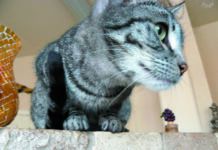Q: I have worked for a spay/neuter non-profit organization called ‘Forgotten Felines of Sonoma County’ for the past 16 years, and we deal primarily with stray and feral cats. Over the past two years, we have been seeing a condition that is commonly known here as “puffy pad disease.” We would like to know what information you can share about this malady — how it starts, how it may be treated and its prognosis. -Taylor Page
A: You’re describing a condition in cats called feline plasma cell pododermatitis (FPP), and it is sometimes called “Pillow Foot.” I haven’t heard it referred to as “puffy pad disease,” but the name is appropriate because the foot pad of the affected foot (or feet) develops a characteristic swollen, puffy appearance. Pododermatitis means “inflammation involving the skin on the foot.” In this case, the inflammation is due to infiltration of the pad with plasma cells, which are a type of cell of the immune system. The cause of FPP remains unknown, although the fact that immune cells are involved suggests some sort of overstimulation of the immune system. FPP usually involves more than one foot. No particular breed is predisposed, nor is there any particular age or sex predilection. Clinical signs can vary from cat to cat. Some cats aren’t bothered by it, while other cats may limp and show signs of pain when the foot is examined. Blood tests often show an elevated number of lymphocytes as well as an increased level of globulin — a type of protein — in the bloodstream. A definitive diagnosis is obtained by biopsy of an affected pad, but this usually isn’t necessary, given the characteristic appearance with this disorder. Because immune stimulation is suspected to be involved in the disease, treatment involves suppressing the immune response. Initially, the drug doxycycline is prescribed. Although doxycycline is an antibiotic, it does modulate the immune system, and most cats respond well to the treatment. Cats that show a poor response to doxycycline can be given a steroid such as prednisolone. Steroid treatment is usually very effective in controlling the disorder. In some patients, food hypersensitivity has been associated with FPP, and treatment with a hypoallergenic diet may cause improvement in the condition. The course of FPP can vary greatly. In some cats, the condition resolves spontaneously, while other cats may require lifelong therapy.
Arnold Plotnick, DVM, DACVIM
Catnip contributor



